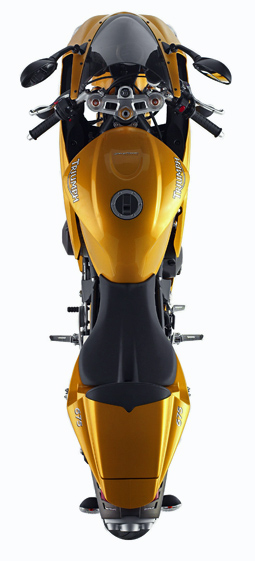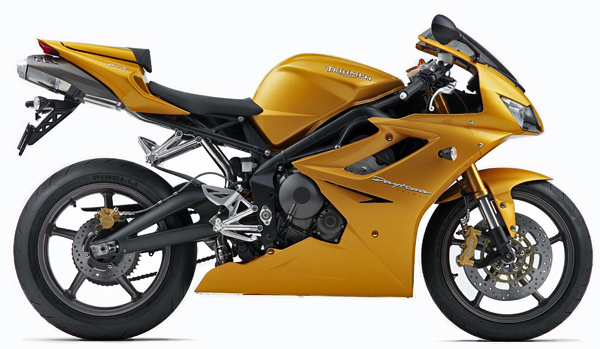
When we first heard that Triumph was developing yet another four-cylinder sport bike a few years ago following the introduction of their 600cc supersport machine, we could hardly believe it, and offered our opinion that Triumph was headed in the wrong direction (see our article dated January 5, 2001). Running straight into the teeth of the Japanese when Triumph already had a heritage involving three-cylinder machinery made no sense to us. Although we would not presume that Triumph lent any weight to our opinion (typically, they don’t even return our phone calls), Triumph apparently reached the same conclusion at some point when development of the new Daytona 675 began, and the larger-displacement, four-cylinder sport bike was dropped from development altogether.
As you probably already know, the Daytona 675 is a proper three-cylinder Triumph displacing 675cc. Last year’s 600 sport bike will be dropped from the Triumph lineup in favor of this unique-to-the-market machine. Your first reaction may be luke warm, but after reading Triumph’s specifications for the new middleweight and having seen it in the flesh at a posh press event here in Southern California Wednesday, I have to admit I am pretty enthusiastic about the Daytona 675.

Although at first glance, in pictures, the styling may look somewhat generic and similar to a Kawasaki ZX-6R, for instance, in person the bike is stunning and evidences some new design directions taken by Triumph. Most notable would be the slender waist of the Daytona 675, which is genuinely reminiscent of sitting aboard a 250cc two-stroke. It is not just more slender than the Japanese 600s, it is dramatically more slender at the point where the rider’s knees hug the machine.
To do this, it appears that Triumph took the already narrow three-cylinder design (inherently less wide than a four-cylinder), wrapped the perimeter frame over the top of the engine (rather than running it around the side as was the norm a few years ago) and, in addition, curved the frame toward the center line of the bike. It actually appears that your knees hug the tank in a position that is less wide than the cylinder head itself, for instance. This feature alone is enough to give the Daytona 675 its own character, but there is more.
The unique displacement of 675cc yields a per-cylinder displacement of 225cc. By contrast, a four-cylinder 600cc machine displaces 150cc per cylinder. The result is that, although the peak of 123 horsepower is delivered at a heady 12,500 rpm, usable torque is delivered from below 5,000 rpm, whereas a 600cc, four-cylinder machine can need 7 or 8 thousand rpm on the tachometer before punchy torque levels arise. Triumph claims the Daytona 675 provides as much torque at 5,000 rpm as most 600s provide at 10,000 rpm.
This type of power delivery can only make street riding easier and quicker. Despite the relative grunt down low, Triumph also says that a healthy top-end rush arrives above 10,000 rpm.
The three-cylinder exhaust note should also please a good number of sport bike enthusiasts. It somehow seems to marry the best traits of the sound emitted by a v-twin with those emitted by a four. We have not heard the Daytona 675 running, but we have yet to listen to a three-cylinder at full song without being pleased.
We mentioned earlier that Bike Magazine in England had tested the Daytona 675 and pronounced it a great bike. No American journalist has had the opportunity to test the Daytona 675 (as far as we know). Nevertheless, this is clearly the bike Triumph should have made several years ago when it instead chose to take on the Japanese on their home turf with an in-line, four-cylinder 600.

The specifications of the Daytona 675 fall in line with the standards set for modern sport bike machinery. Adjustable Kayaba suspension front and rear is attached to a modern lightweight frame design and equally modern, light wheels with the latest disc brake technology.
The front brake feature a radial master cylinder operating two radial four-piston calipers squeezing 308mm discs. A single piston caliper squeezes a 220mm disc on the rear wheel.
In addition to the typical information, the new instrument cluster provides average fuel ecomony readings, as well as a 99 lap memory timer. Gear position indicator and gear change shift light are also included.

Consistent with Triumph’s prior practice, several accessories will be available when the Daytona 675 reaches dealers here in the United States next Spring, including various carbon fibre bits and a titanium Arrow exhaust system that reduces weight by 13 pounds and adds 5 horsepower (for off-road use only, of course).
In addition to the Scorched Yellow shown in these photos, the Daytona 675 will be available in Tornado Red and Graphite Grey.
Perhaps, most impressive is the price. At an U.S. MSRP of $8,999, the Daytona 675 is only a few hundred dollars more expensive than the Japanese 600s, and several thousand dollars cheaper than a Ducati 749. For buyers looking for that extra bit of exclusivity without the Ducati price, the Daytona 675 may be just the ticket. You can bet we will hound Triumph in an effort to obtain an early test ride. Stay tuned.






